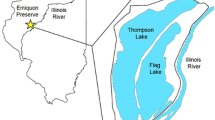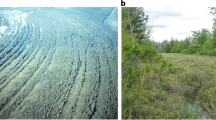Abstract
Restoration of disturbed wetland systems is an important component of wetland mitigation, yet uncertainty remains about how hydrologic processes affect biologic processes and wetlands patterns. To design more effective restoration strategies and re-establish native plant communities in disturbed wetlands, it is imperative to understand undisturbed systems. A site within Cherokee Marsh located in Madison, Wisconsin, USA, contains a relatively undisturbed area of wetland consisting of plant communities common within the prairie landscape including a fen, sedge meadow, and shallow marsh. These distinct communities are found within an area of minimal topographic relief, yet transitions from one community to the next occur over short distances. This study sought to characterize the geologic, hydrologic, and chemical gradients associated with these shifts in vegetation to gain insight into the factors controlling the spatial differences in dominant plant species, which could be critical for restoration success. Vegetation analyses revealed a transition of dominant sedge species, which appeared to correspond to changes in hydrology from a ground-water dominated to a surface-water dominated system (as determined by water isotopes). Along the same vegetation transect, subsurface coring results show a heterogeneous composition of peat and till with lateral and vertical variations in stratigraphy, which relates to variability in ground-water discharge as evidenced by hydroperiods and stable isotope composition. Applications of this type of approach throughout the glaciated terrains of the midwestern and northeastern United States and Canada can improve future wetland restoration and management.
Similar content being viewed by others
Literature Cited
Anderson, K. M. 2002. Hydrogeologic controls on flow to Frederick Springs in the Pheasant Branch Watershed, Middleton, Wisconsin. M.S. Thesis. University of Wisconsin, Madison, WI, USA.
Bedford, B. L., M. R. Walbridge, and A. Aldous. 1999. Patterns in nutrient availability and plant diversity of temperate North American wetlands. Ecology 80: 2151–69.
Bedford, B. L., E. H. Zimmerman, and J. H. Zimmerman. 1974. Wetlands of Dane County, Wisconsin. Dane County Regional Planning Commission, Madison, WI, USA.
Bendjoudi, H., P. Weng, R. Guerin, and J. F. Pastre. 2002. Riparian wetlands of the middle reach of the Seine River (France): historical development, investigation and present hydrologic functioning. A case study. Journal of Hydrology 263: 131–55.
Bernthal, T. 2003. Development of a floristic quality assessment methodology for Wisconsin. Final report to USEPA Region V. Madison, WI, USA. Wetland Grant #CD-975115-01-0.
Bradbury, K. R., S. K. Swanson, J. T. Krohelski, and A. K. Fritz. 1999. Hydrogeology of Dane County, Wisconsin. Wisconsin Geological and Natural History Survey, Madison, WI, USA. Open-File Report 1999-4.
Carpenter, Q. J. 1995. Toward a new definition of calcareous fen in Wisconsin. Ph.D. Dissertation. University of Wisconsin, Madison, WI, USA.
Clayton, L. and J. W. Attig. 1997. Pleistocene Geology of Dane County Wisconsin. Wisconsin Geology and Natural History Survey, Madison, WI, USA. Wisconsin Geologic Survey Bulletin 95.
Coplen, T. B., J. D. Wildman, and J. Chen. 1991. Improvements in the gaseous hydrogen water equilibration technique for hydrogen isotope ratio analysis. Analytical Chemistry 63: 910–12.
Curtis, J. T. 1959. The Vegetation of Wisconsin. University of Wisconsin Press, Madison, WI, USA.
Drexler, J. Z. and B. L. Bedford. 2002. Pathways of nutrient loading and impacts on plant diversity in a New York peatland. Wetlands 22: 263–81.
Eggers, S. D. and D. M. Reed. 1997. Wetland Plants and Plant Communities of Minnesota and Wisconsin, second edition. U. S. Army Corps of Engineers, St. Paul, MN, USA.
Epstein, S. and T. Mayeda. 1953. Variation of 18O content of water from natural sources. Geochimica Cosmochimica Acta 4: 213–24.
Fetter, C. W. 1994. Applied Hydrogeology, third edition. Prentice-Hall Inc., Upper Saddle River, NJ, USA.
Gauch, H. G. Jr. 1982. Multivariate Analysis in Community Ecology. Cambridge University Press, New York, NY, USA.
Gerla, P. J. 1992. The relationship of water-table changes to the capillary fringe, evapotranspiration, and precipitation in intermittent wetlands. Wetlands 12: 91–98.
Hite, C. D. and S. Cheng. 1996. Spatial characterization of hydrogeochemistry within a constructed fen, Greene County, Ohio. Ground Water 34: 415–25.
Hunt, R. J. 1996. Do created wetlands replace the wetlands that are destroyed? U. S. Geological Survey Fact Sheet FS-246-69.
Hunt, R. J., T. D. Bullen, D. P. Krabbenhoft, and C. Kendall. 1998. Using stable isotopes of water and strontium to investigate the hydrology of a natural and constructed wetland. Ground Water 36: 434–43.
Hunt, R. J., J. O. Jackson, G. L. Running, D. P. Krabbenhoft, and J. T. Krohelski. 1999a. Hydrogeological, geomorphological, and vegetative investigations of select wetland creation and restoration projects. Federal Highway Administration, Department of Transportation, Washington, DC, USA. SPR/ 0092/45/91.
Hunt, R. J., D. P. Krabbenhoft, and M. P. Anderson. 1996. Groundwater inflow measurements in wetland systems. Water Resources Research 32: 495–507.
Hunt, R. J., D. P. Krabbenhoft, and M. P. Anderson. 1997. Assessing hydrogeochemical heterogeneity in natural and constructed wetlands. Biogeochemistry 39: 271–93.
Hunt, R. J. and J. J. Steuer. 2000. Simulation of the recharge area for Frederick Springs, Dane County, Wisconsin. United States Geological Survey, Washington, DC, USA. Water-Resources Investigations Report 00-4172.
Hunt, R. J., J. F. Walker, and D. P. Krabbenhoft. 1999b. Characterizing hydrology and the importance of ground-water discharge in natural and constructed wetlands. Wetlands 19: 458–72.
Kendall, C. 1993. Impact of isotopic heterogeneity in shallow system on modeling of streamflow generation. Ph.D. Dissertation. University of Maryland, College Park, MD, USA.
Klijn, F. and J. M. Witte. 1999. Eco-hydrology: groundwater flow and site factors in plant ecology. Hydrogeology Journal 7: 65–77.
Lee, D. R. and J. A. Cherry. 1978. A field exercise on groundwater flow using seepage meters and mini-piezometers. Journal of Geological Education 27: 6–10.
Lott, R. B. and R. J. Hunt. 2001. Estimating evapotranspiration in natural and constructed wetlands. Wetlands 21: 614–28.
Mauer, D. A., R. Lindig-Cisneros, K. J. Werner, S. Kercher, R. Miller, and J. B. Zedler. 2003. The replacement of wetland vegetation by Phalaris arundinacea (reed canary grass). Ecological Restoration 21: 116–19.
McDermott, A. L. 2004. Hydrogeologic and vegetative gradients across a wetland transect in south central Wisconsin. M.S. Thesis. University of Wisconsin, Madison, WI, USA.
Midwestern Regional Climate Center (MRCC). 2003. Madison Dane County Airport weather station data, 1971–2000. Madison, WI, USA. http://www.mcc.sws.uiuc.edu.
Mitsch, W. J. and J. G. Gosselink. 2000. Wetlands, third edition. John Wiley & Sons Inc., New York, NY, USA.
Price, J. 1997. Soil moisture, water tension, and water table relationships in a managed cutover bog. Journal of Hydrology 22: 263–81.
Reed, D. M. 2002. Environmental correlates of vegetation types in southeastern Wisconsin fens. Ph.D. Dissertation. University of Wisconsin, Milwaukee, WI, USA.
Reston Stable Isotopes Laboratory (RSIL). 2003. USGS Stable Isotope Laboratory. Reston, VA, USA. http://isotopes.usgs. gov/Methods.htm.
Rosenberry, D. O. and T. C. Winter. 1997. Dynamics of watertable fluctuations in an upland between prairie-pothole wetlands in North Dakota. Journal of Hydrology 191: 266–89.
Shedlock, R. J., D. A. Wilcox, T. A. Thompson, and D. A. Cohen. 1993. Interactions between ground water and wetlands, southern shore of Lake Michigan, USA. Journal of Hydrology 141: 127–55.
Siegel, D. I. 1981. Hydrogeologic setting of the Glacial Lake Agassiz Peatlands, northern Minnesota. United States Geologic Survey, Washington, DC, USA. Open File Report 80-403.
Siegel, D. I. 1983. Groundwater and the evolution of patterned mires, Glacial Lake Agassiz Peatlands, Northern Minnesota. Journal of Ecology 71: 913–21.
Sjörs, H. 1950. On the relation between vegetation and electrolytes in north Swedish mire waters. Oikos 2: 241–58.
Stites, W. and L. W. Chambers. 1991. A method for installing miniature multilevel sampling wells. Ground Water 29: 430–32.
Swanson, S. K., J. M. Bahr, and K. W. Potter. 2006. A local meteoric water line for Madison, Wisconsin. Wisconsin Geological and Natural History Survey Open-File Report 2006-01.
Thompson, T. A., C. S. Miller, P. K. Doss, L. D. P. Thompson, and S. J. Baedke. 1991. Land-based vibracores analysis: tips, tricks, and traps. Indiana Geological Survey, Bloomington, IN, USA. Occasional Paper 58.
Turner, J. V., A. Arad, and C. D. Johnston. 1987. Environmental isotope hydrology of salinized experimental catchments. Journal of Hydrology 94: 89–107.
U. S. Army Corps of Engineers (USACE). 1987. U.S. Army Corps of Engineers wetland delineation manual. Department of the Army, Washington, DC, USA. Y-87-1.
University of Wisconsin Soil and Plant Laboratory (UWSPL). 2003. Madison, WI, USA. http://uwlab.soils.wisc.edu.
(WETS) Climate analysis for wetlands. 2004. U. S. Department of Agriculture, Natural Resources Conservation Service, National Water and Climate Center, Beltsville, MD, USA. http:// www.wcc.nrcs.usda.gov/climate/wets_doc.html.
White, J. W. C., E. R. Cook, J. R. Lawrence, and W. S. Broecker. 1985. The D/H ratio of sap in trees: Implications for water resources and tree D/H ratios. Geochimica Cosmochimica Acta 49: 237–46.
Winter, T. C., D. O. Rosenberry, D. C. Buso, and D. A. Merk. 2001. Water source to four U.S. wetlands: implications for wetland management. Wetlands 21: 462–73.
Zimmerman, U., D. Ehalt, and K. O. Munnich. 1967. Soil-water movement and evapotranspiration: Changes in the isotopic composition of the water. p. 567–84. In Proceedings of the Symposium on Isotopic Hydrology Vienna: International Atomic Energy Agency, Vienna, Austria.
Author information
Authors and Affiliations
Corresponding author
Rights and permissions
About this article
Cite this article
Kurtz, A.M., Bahr, J.M., Carpenter, Q.J. et al. The importance of subsurface geology for water source and vegetation communities in Cherokee Marsh, Wisconsin. Wetlands 27, 189–202 (2007). https://doi.org/10.1672/0277-5212(2007)27[189:TIOSGF]2.0.CO;2
Received:
Revised:
Accepted:
Issue Date:
DOI: https://doi.org/10.1672/0277-5212(2007)27[189:TIOSGF]2.0.CO;2




